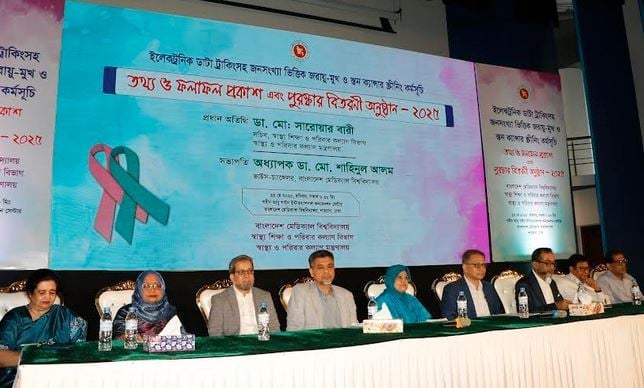News Flash
News Flash

DHAKA, May 25, 2025 (BSS) - The rate of cervical cancer infection is highest among women aged 35 to 39 while main cause of this cancer is high-risk human papillomavirus (HR-HPV), said a new research report.
The report was published at Shaheed Abu Sayeed International Convention Center of Bangladesh Medical University (BMU) this afternoon.
Medical Education and Family Welfare Secretary Dr. Md. Sarwar Bari spoke as the chief guest with Bangladesh Medical University Vice-Chancellor Professor Dr. Md. Shahinul Alam in the chair.
The researchers are hopeful that the results of this study will play an important role in the effective development and policy-making of cervical and breast cancer screening in the country.
The results of the study say that an analytical study was conducted on 3,856 women in urban versus rural settings under the leadership of BMU Professor Dr. Shirin Akhter Begum.
In this study, the overall rate of HR-HPV infection was 3.6 percent, which is 138 people in number. The highest prevalence was in Sylhet (6.4 percent) and the lowest in Rajshahi (1.7 percent). The prevalence in rural areas of Sylhet was 7.1 percent, which is higher than in urban areas. The study found the highest prevalence among those aged 35 to 39 years.
The study was conducted in three districts of the coastal region of Bangladesh under the leadership of BMU Associate Professor Dr. Noor-e-Ferdous.
The study conducted among 900 married women in Jhalokati, Cox's Bazar, and Bagerhat found the prevalence of HR-HPV to be 2.56 percent, which was 26 in number.
The highest prevalence was found in Jhalokati, which was 3 percent. The study recommends the introduction of genotyping-based screening to prevent cervical cancer in this region.
Genealogist Dr. Mst. Zakanta Faika carried out a comparative study of screening methods where 4,792 women were divided into two groups to evaluate the effectiveness of screening with Via + HPV and HPV alone.
The Via + HPV method had a positivity rate of 5.9%, while the HPV method alone had a positivity rate of 3.7%. The combined method had a higher detection rate and follow-up rate, suggesting that it could help increase the effectiveness of the screening programme.
Dr. Asma Akter Sonia conducted a pilot study on high-risk HPV testing in cervical cancer screening in two upazilas of Bangladesh.
The aim of the study was to identify the role of high-risk HPV testing, including genotyping, in cervical cancer screening in Bangladesh.
The study was conducted on 10,000 women aged 30 to 60 years from each study area. The study found that 3.2%, or 318 women, were infected with HR-HPV. Among all women, 1 percent, which is 97 women, had HPV type 16 and 0.2 percent, 20 women had HPV type 18.
The prevalence of HR-HPV in this study was relatively low (3.2 percent). HR-HPV test was proven to exhibit high sensitivity compared to Viagra.
In the study on breast cancer screening, Dr. Sadia Rasul's study showed high sensitivity (93.3 percent) and specificity (97.6 percent) in detecting breast cancer in combination with clinical breast examination (CBE) and mammography, indicating the importance of CBE in detecting cancer at an early stage.
At the national level, screening activities were conducted and evaluated through e-HIS, an electronic health information system based on DHIS2, in Rajshahi division under the leadership of BMU Professor Ashrafunnesa. As of April 2024, 14,213 community clinics in the country have used this platform.
Through this, it has been possible to establish an effective link between screening, colposcopy and tracking.
However, poor internet connectivity and limitations related to national identity cards have emerged as a major challenge.
Out of 60, 93, 224 women who were screened for cervical cancer, 2,05,358 were found positive, which is a percentage of 3.37 percent. It has been possible to bring 21 percent of the target number of women under the screening programme in Bangladesh.